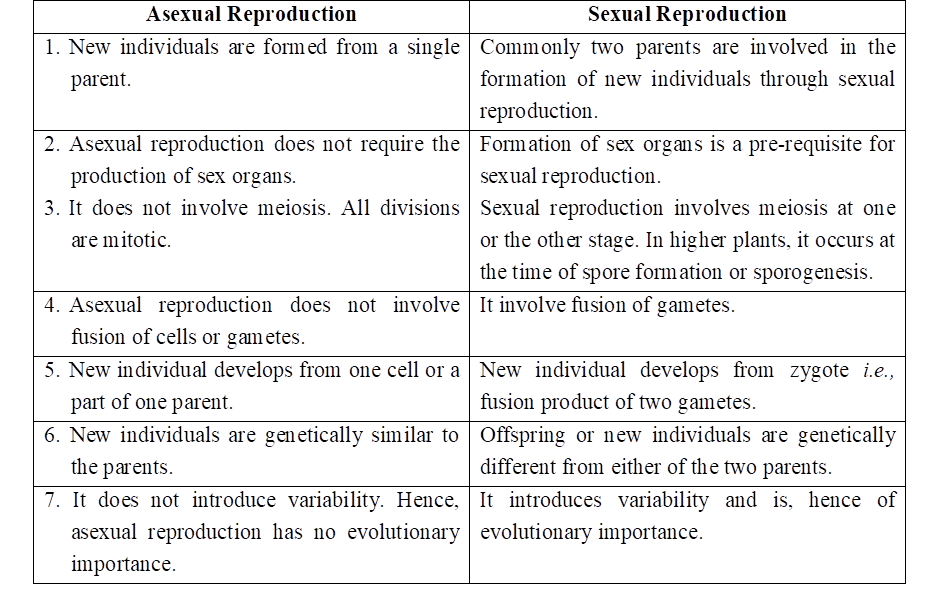- Books Name
- A TEXT OF BIOLOGY - CLASS XII
- Publication
- ACME SMART PUBLICATION
- Course
- CBSE Class 12
- Subject
- Biology
SEXUAL REPRODUCTION
Sexual reproduction involves formation and fusion of gametes to form the zygote which develops to form the new organism.
Characteristics
1. Two fusion gametes can be produced by same individual or different individuals. So it can be both uniparental as well as biparental (mostly).
2. Offsprings produced are not identical to parents or amongst themselves.
3. It involves meiosis and syngamy.
4. It is a slow, elaborate or complex process. So multiplication is not so rapid.
All organisms have to reach a certain stage of growth and maturity in their life cycle before they reproduce sexually. For understanding this better lets study the different phases in the life cycle of organism.
Table: Differences between Asexual and Sexual Reproduction

Phases in Life Cycle
Three phases are there in the organism's life cycle.
1. Juvenile phase
2. Reproductive phase
3. Senescent phase
1. Juvenile phase/pre-reproductive phase
During this phase organism will show growth so that it can attain certain maturity to perform the sexual reproduction.
This phase is known as vegetative phase in plants. It is of variable durations in different organisms.
2. Reproductive phase
Reproductive organs develop and mature during this phase. In the higher plants, end of juvenile phase or onset of reproductive phase is easily marked.
In the higher plants during this phase, there is formation of reproductive structures i.e., flowers.
The motto of this phase is to produce the offsprings which may be similar or dissimilar to parental generation. This phase is also of variable durations in different organisms.
Based upon flowering and fruiting pattern there are two types of flowering plants, i.e., monocarpic and polycarpic.
Monocarpic Plants :
They are plants which flower only once in their life. After flowering, they produce fruits and die. All annuals (e.g., Wheat, Rice, Marigold) and biennial plants (e.g., Radish, Carrot, Henbane), are monocarpic.
A few perennial plants are also monocarpic. Certain bamboo species (e.g., Bambusa tulda, Meloeanna bambusoides) live vegetatively for 50-100 years, flower and fruit abundantly and then die.
Strobilanthus kunthiana (vern. Neelakurinji) flowers once in 12 years.
The last time it flowered was September-October 2006. The flowering converted large hilly tracts of Kerala, Karnataka and Tamil Nadu into blue stretches that attracted a large number of tourists.
Polycarpic Plants :
They are perennial plants which after reaching maturity, flower repeatedly at intervals, e.g., Mango, Apple, Jackfruit, Grape vine, Orange.
Very few perennial plants bear flowers throughout the year, e.g., China rose (Shoe Flower). The period between two flowering phases is called Inter flowering period which is used for building up resources and is, therefore, a recovery phase. It is not the juvenile phase but is part of the mature phase.
3. Senescent Phase:
It is a post-reproductive phase. It involves structural and functional deterioration of body by accumulation of waste metabolites which ultimately leads to death.
In both plants and animals, hormones are responsible for the transitions between three phases. Interaction between hormones and certain environmental factors regulate the reproductive processes and the associated behavioural expressions of organisms.
Concept Builder
The females of placental mammals exhibit cyclical changes in the activities of ovaries and accessory ducts as well as hormones during the reproductive phase.
In non-primate mammals like cows, sheep, rats, deers, dogs, tiger, etc., such cyclical changes during reproduction are called oestrus cycle.
Where as in primates (monkeys, apes, and humans) it is called menstrual cycle.
Many mammals, especially those living in natural, wild conditions exhibit such cycles only during favourable seasons in their reproductive phase and are therefore called seasonal breeders.
Many other mammals are reproductively active throughout their reproductive phase and hence are called continuous breeders.

 ACME SMART PUBLICATION
ACME SMART PUBLICATION
